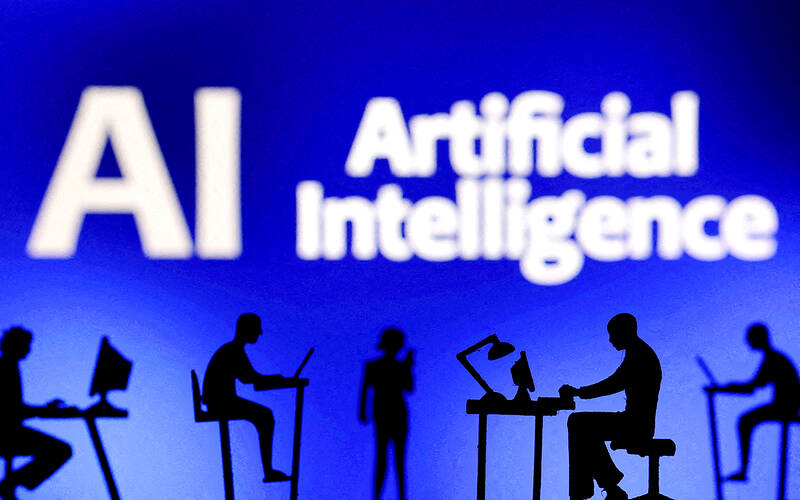President William Lai (賴清德) is determined to make Taiwan Asia’s “AI Island” — not just in terms of chips and hardware, but also in terms of Taiwan’s traditional weakness: research and software. With its innovative and entrepreneurial use of Artificial Intelligence (AI), Taipei Medical University (TMU) is leading the way on the research front. In fact, it is creating a map for others to follow.
Research is like an expedition into the unknown, where systematic investigation and exploration lead to new insights and discoveries. Just as explorers chart new territories to uncover valuable resources and solutions, researchers drive innovation and economic growth by developing new technologies and addressing societal challenges. By investing in research, governments and organizations equip themselves for long-term resilience and competitiveness in an ever-evolving landscape.
If research is like an expedition, traditional pre-AI research often explored fragmented routes with different disciplines paving their own road systems. In Taiwan, local research has historically been hampered by language and cultural barriers that often prevented the creation of broad and connected networks.

Photo: Reuters
The lack of these intersecting roadways limited the exchange of ideas and research collaborations, especially between countries and across disciplines. Funding constraints also kept these institutions from upgrading their maps to the digital era, leaving them stuck on old, inefficient routes with limited navigation systems.
AI SOLUTIONS
AI has the potential to help solve these problems. President Lai certainly thinks so. In his inaugural address last year, he said that to make Taiwan an AI island, “[w]e must adapt AI for industry and step up the pace of AI innovation and applications. We must also adapt industry for AI and use AI’s computational power to make our nation, our military, our workforce and our economy stronger.”
Researchers and research institutions have a key role to play here. With the right workflows within the right organizational vision and ecosystem, AI can be used to accelerate research productivity and also amplify researcher intelligence.
The rapid advance of AI and large language model (LLM) tools has dramatically sped up the research process of discovering patterns, acquiring knowledge and generating insights. As Deputy Director of the TMU Research Center for AI, Chang Yung-chun (張詠淳) says, “What once took weeks of manual effort can now be accomplished in a matter of hours — unlocking new insights and accelerating innovation across the board.”
This means that researchers can handle multiple projects and publish results more quickly, which is critical for keeping up with the pace of modern research in fast moving disciplines like AI and data science. In fact, since its inception in 2019, the TMU Research Center for AI has completed over 600 projects and produced more than 5,000 published research papers.
But AI is not just useful to accelerate research productivity and amplify intelligence, it can connect intelligences — the intelligences of different researchers and different disciplines. This is important because innovation often comes at the intersection of different fields of study.
TMU recognizes this and has set up research ecosystems that use AI to connect intelligences.
TMU: A BUSINESS AND AI MINDSET
TMU has created a thriving entrepreneurial research ecosystem. As a private institution, it has fewer bureaucratic hurdles and embodies more of an entrepreneurial attitude to raise funding, motivate faculty and attract students. This means TMU can swiftly respond to emerging trends in healthcare and technology and create an innovative environment where researchers can more easily collaborate and more effectively implement AI tools.
Several years ago, former TMU president Lin Chien-huang (林建煌) redesigned the research incentive system to encourage faculty engagement in research and development.
“Previously, faculty received only 40 percent of technology transfer funds; we’ve increased it to a minimum of 70 percent and up to 80 percent, reducing the university’s share,” he said.
Chang says this allows TMU’s clinical physicians to “embody the spirit of entrepreneurs — constantly exploring innovative ways to address unsolved clinical problems with AI.”
And as a data scientist himself, he describes his role as a chief technology officer that provides cutting-edge AI solutions to help solve these problems.
This system, combined with systematic management and leadership courses, has significantly stimulated the business mindset and management thinking, transforming TMU faculty and research teams into entrepreneurial leaders.
THE ECOSYSTEM MAPPER
That is why the Office of Data Science (ODS) was established in 2019. It is an independent entity that facilitates research by providing data integration, statistical support and collaborative opportunities for healthcare projects.
Born of TMU’s business mindset and emerging AI technologies, the ODS was a strategic initiative to “not just to manage data, but to ignite innovation,” Lin says. “By empowering researchers with the right tools and ecosystem, we can turn data into value and research into enterprise … This is how a medical university becomes an engine for biomedical entrepreneurship and strategic AI advancement.”
The ODS underscores the importance of data in research, especially AI research. The “No data, no AI” truism especially applies to clinical settings, where access to quality data is often a significant hurdle.
We can think of the ODS as Google Maps replacing outdated paper maps. It is a constantly updated and integrated data and research network that serves three primary functions.
First, the ODS acts as a comprehensive data hub and integrates different types of clinical information through a Common Data Model — like a major highway that integrates various data sources into a unified, navigable route. It also offers advanced analytical tools that serve as navigational aids to guide researchers through the complex data landscape to uncover valuable insights. Thirdly, the ODS makes possible interdisciplinary intersections and creates collaborative junctions where different fields and institutions converge to accelerate medical research and innovation.
So, when a doctor notices a potential research pattern in clinical data, she can work with the Office of Data Science to extract and clean that data, then use AI to validate or refine the hypothesis; after this, she can publish the research findings or use it in industry settings.
RESEARCH IMPLICATIONS
By redrawing the research map with its AI Research Center and ODS, TMU is demonstrating how a centralized, AI-powered ecosystem can accelerate research and bridge long-standing gaps between disciplines and institutions.
What makes this ecosystem “truly remarkable,” Chang says, is its “collaborative nature.”
Data science students and researchers equipped with data science skills are embedded in real-world interdisciplinary projects with seasoned physicians and their students in research and mentoring feedback loops.
Chang says that the rise of AI has accelerated this process to make “collaboration faster, workflows smoother and innovation more accessible than ever before. We are, without a doubt, living in a golden age of AI in medical research.”
Faster and more effective collaborations are especially critical in a world where breakthroughs often emerge at the intersections of diverse fields.
The rise of AI is lowering barriers to collaboration. Language — even technical knowledge — is no longer an obstacle, and the threshold for interdisciplinary and international exchange is rapidly shrinking.
TMU’s AI-driven innovative research ecosystem positions it as a trailblazer in Taiwan’s shift from Silicon Island to AI Island. The Office of Data Science offers an ambitious blueprint — or perhaps more aptly, a research roadmap — for others to follow.

June 9 to June 15 A photo of two men riding trendy high-wheel Penny-Farthing bicycles past a Qing Dynasty gate aptly captures the essence of Taipei in 1897 — a newly colonized city on the cusp of great change. The Japanese began making significant modifications to the cityscape in 1899, tearing down Qing-era structures, widening boulevards and installing Western-style infrastructure and buildings. The photographer, Minosuke Imamura, only spent a year in Taiwan as a cartographer for the governor-general’s office, but he left behind a treasure trove of 130 images showing life at the onset of Japanese rule, spanning July 1897 to

One of the most important gripes that Taiwanese have about the Democratic Progressive Party (DPP) is that it has failed to deliver concretely on higher wages, housing prices and other bread-and-butter issues. The parallel complaint is that the DPP cares only about glamor issues, such as removing markers of Chinese Nationalist Party (KMT) colonialism by renaming them, or what the KMT codes as “de-Sinification.” Once again, as a critical election looms, the DPP is presenting evidence for that charge. The KMT was quick to jump on the recent proposal of the Ministry of the Interior (MOI) to rename roads that symbolize

In an interview posted online by United Daily News (UDN) on May 26, current Chinese Nationalist Party (KMT) Chairman Eric Chu (朱立倫) was asked about Taichung Mayor Lu Shiow-yen (盧秀燕) replacing him as party chair. Though not yet officially running, by the customs of Taiwan politics, Lu has been signalling she is both running for party chair and to be the party’s 2028 presidential candidate. She told an international media outlet that she was considering a run. She also gave a speech in Keelung on national priorities and foreign affairs. For details, see the May 23 edition of this column,

On the evening of June 1, Control Yuan Secretary-General Lee Chun-yi (李俊俋) apologized and resigned in disgrace. His crime was instructing his driver to use a Control Yuan vehicle to transport his dog to a pet grooming salon. The Control Yuan is the government branch that investigates, audits and impeaches government officials for, among other things, misuse of government funds, so his misuse of a government vehicle was highly inappropriate. If this story were told to anyone living in the golden era of swaggering gangsters, flashy nouveau riche businessmen, and corrupt “black gold” politics of the 1980s and 1990s, they would have laughed.